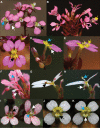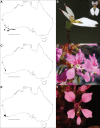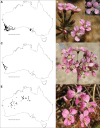Styleworts under the microscope: a taxonomic account of Levenhookia (Stylidiaceae)
- PMID: 32587460
- PMCID: PMC7305247
- DOI: 10.3897/phytokeys.151.51909
Styleworts under the microscope: a taxonomic account of Levenhookia (Stylidiaceae)
Abstract
A taxonomic revision of the Australian endemic genus Levenhookia R.Br. (Stylidiaceae) recognises 12 species, of which L. aestiva Wege, sp. nov. from south-western Australia is newly described. Levenhookia preissii (Sond.) F.Muell. is lectotypified and recircumscribed as a Swan Coastal Plain endemic, resulting in its addition to the Threatened and Priority Flora List for Western Australia. Lectotypes are also selected for L. dubia Sond., L. leptantha Benth., L. sonderi (F.Muell.) F.Muell. and L. stipitata (Benth.) F.Muell. ex Benth. Verification of herbarium records has expanded the known distribution of L. murfetii Lowrie & Conran and L. pulcherrima Carlquist and has confirmed the widespread distribution of L. dubia across southern Australia including Tasmania, where it is currently listed as extinct-surveys based on information gleaned from historical collections may lead to its rediscovery in this State. Descriptions, distribution maps and photographs for all species are provided along with a key to species.
Keywords: Annual herbs; Flora of Australia; conservation; herbarium collections; taxonomy.
Juliet A. Wege.
Figures







References
-
- Armbruster WS, Edwards ME, Debevec EM. (1994) Floral character displacement generates assemblage structure of Western Australian triggerplants (Stylidium). Ecology 75(2): 315–329. 10.2307/1939537 - DOI
-
- AVH (2019) The Australasian Virtual Herbarium, Council of Heads of Australasian Herbaria, http://avh.chah.org.au [accessed 27.02.2019]
-
- Bentham G. (1837) Stylidieae. In: Endlicher SFL, Bentham G, Fenzl E, Schott H. (Eds) Enumeratio Plantarum Quas in Novae Hollandiae ora austro-occidentali ad Fluvium Cygnorum et in Sinu Regis Georgii collegit Carolus liber baro de Hügel.F. Beck, Vienna, 71–74. https://archive.org/details/enumeratioplant00vongoog/page/n82
-
- Bentham G. (1868) Stylidieae Flora Australiensis (Vol. 4). Reeve & Co., London. 10.5962/bhl.title.141 - DOI
-
- Brown R. (1810) Prodromus florae Novae Hollandiae et Insulae Van-Diemen, exhibens characteres plantarum. R. Taylor, London. 10.5962/bhl.title.3678 - DOI
LinkOut - more resources
Full Text Sources
